reset VOLKSWAGEN UP! 2021 Owner´s Manual
[x] Cancel search | Manufacturer: VOLKSWAGEN, Model Year: 2021, Model line: UP!, Model: VOLKSWAGEN UP! 2021Pages: 211, PDF Size: 5.98 MB
Page 10 of 211
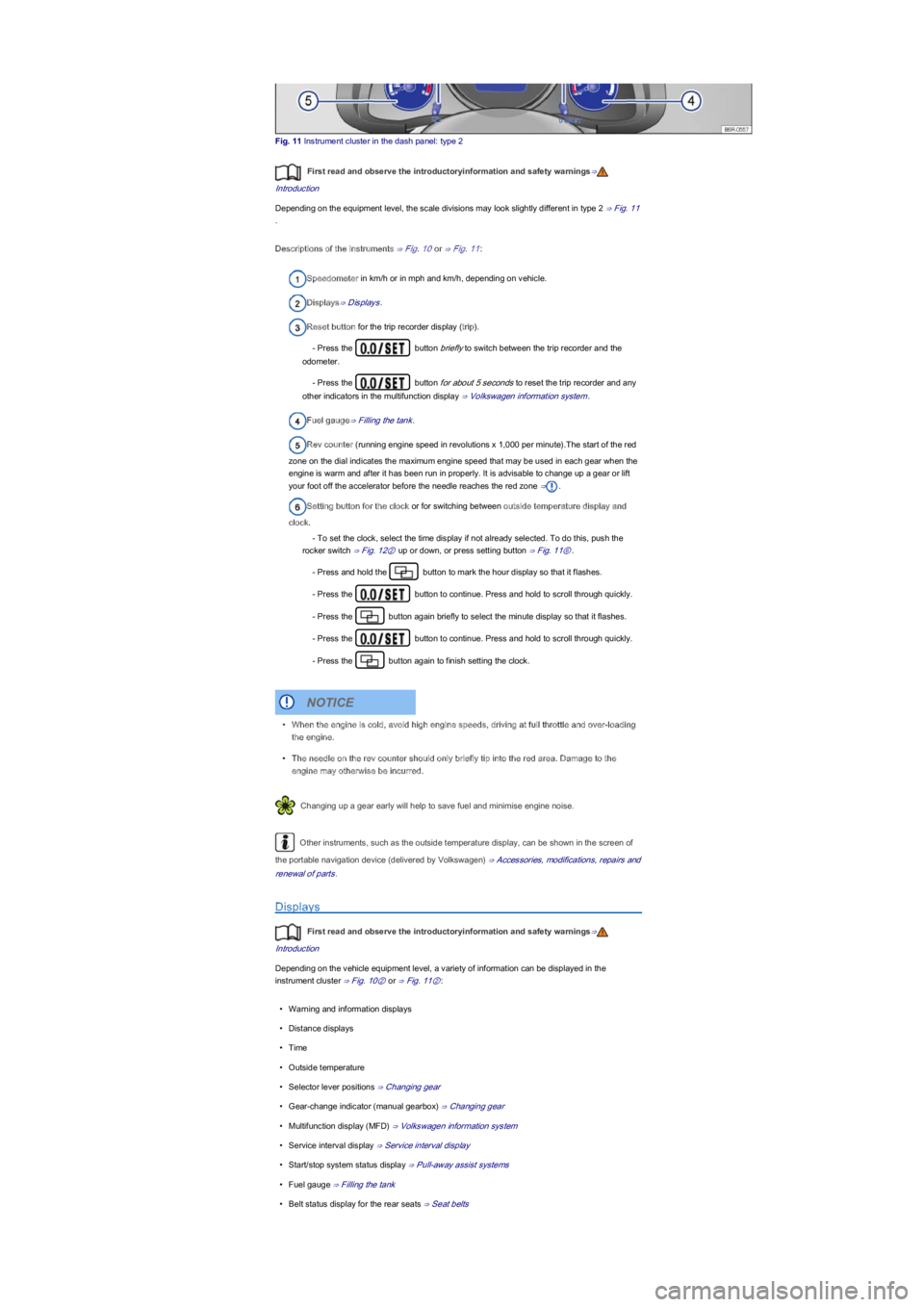
Fig. 11 Instrument cluster in the dash panel: type 2
First read and observe the introductoryinformation and safety warnings⇒
Introduction
Depending on the equipment level, the scale divisions may look slightly different in type 2 ⇒ Fig. 11
.
Descriptions of the instruments ⇒ Fig. 10 or ⇒ Fig. 11:
Speedometer in km/h or in mph and km/h, depending on vehicle.
Displays⇒ Displays.
Reset button for the trip recorder display (trip).
- Press the button briefly to switch between the trip recorder and the
odometer.
- Press the button for about 5 seconds to reset the trip recorder and any
other indicators in the multifunction display ⇒ Volkswagen information system.
Fuel gauge⇒ Filling the tank.
Rev counter (running engine speed in revolutions x 1,000 per minute).The start of the red
zone on the dial indicates the maximum engine speed that may be used in each gear when the
engine is warm and after it has been run in properly. It is advisable to change up a gear or lift
your foot off the accelerator before the needle reaches the red zone ⇒.
Setting button for the clock or for switching between outside temperature display and
clock.
- To set the clock, select the time display if not already selected. To do this, push the
rocker switch ⇒ Fig. 12② up or down, or press setting button ⇒ Fig. 11⑥.
- Press and hold the button to mark the hour display so that it flashes.
- Press the button to continue. Press and hold to scroll through quickly.
- Press the button again briefly to select the minute display so that it flashes.
- Press the button to continue. Press and hold to scroll through quickly.
- Press the button again to finish setting the clock.
Changing up a gear early will help to save fuel and minimise engine noise.
Other instruments, such as the outside temperature display, can be shown in the screen of
the portable navigation device (delivered by Volkswagen) ⇒ Accessories, modifications, repairs and
renewal of parts.
Displays
First read and observe the introductoryinformation and safety warnings⇒
Introduction
Depending on the vehicle equipment level, a variety of information can be displayed in the
instrument cluster ⇒ Fig. 10② or ⇒ Fig. 11②:
•Warning and information displays
•Distance displays
•Time
•Outside temperature
•Selector lever positions ⇒ Changing gear
•Gear-change indicator (manual gearbox) ⇒ Changing gear
•Multifunction display (MFD) ⇒ Volkswagen information system
•Service interval display ⇒ Service interval display
•Start/stop system status display ⇒ Pull-away assist systems
•Fuel gauge ⇒ Filling the tank
•Belt status display for the rear seats ⇒ Seat belts
•When the engine is cold, avoid high engine speeds, driving at full throttle and over-loading
the engine.
•The needle on the rev counter should only briefly tip into the red area. Damage to the
engine may otherwise be incurred.
NOTICE
Page 11 of 211
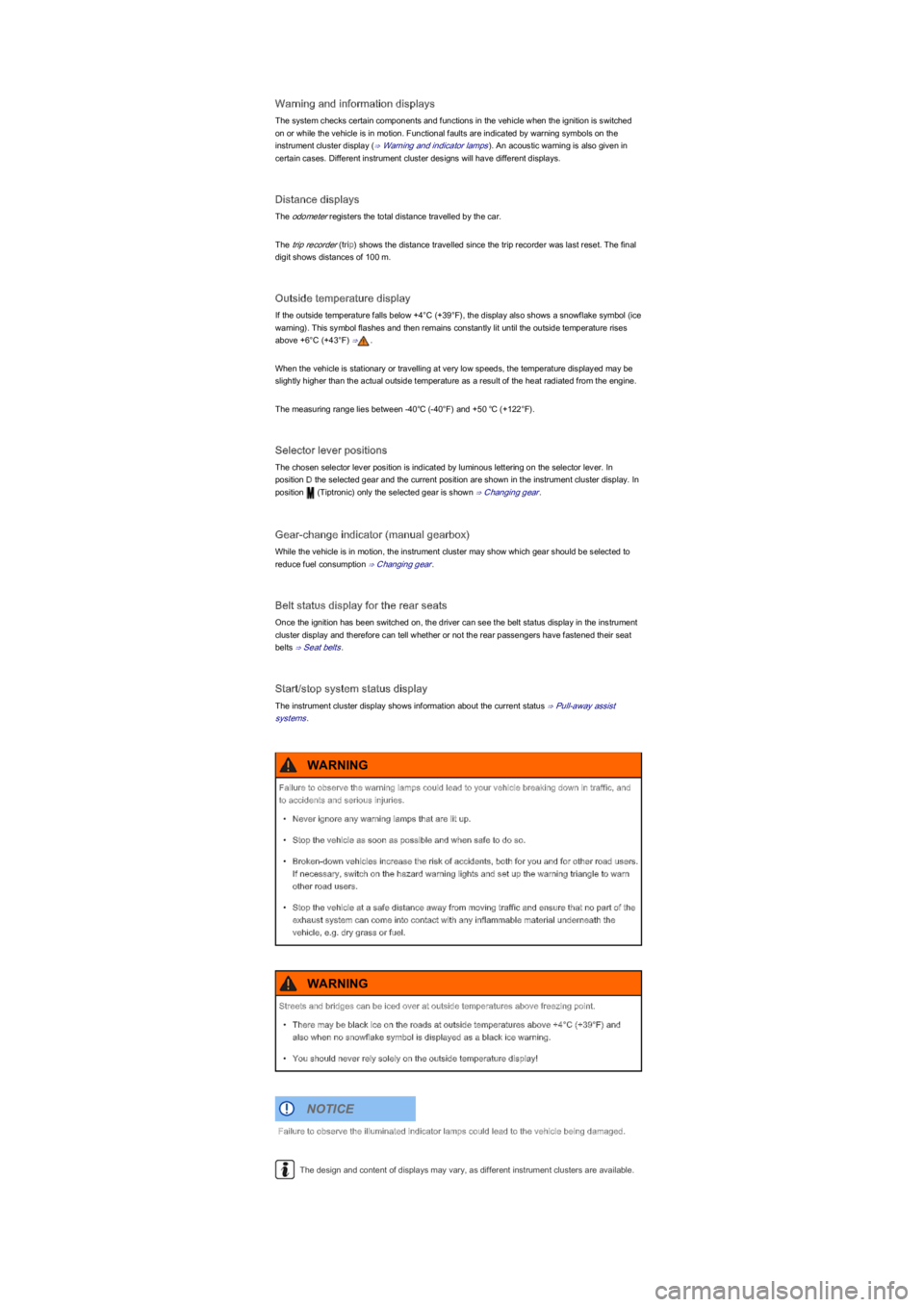
Warning and information displays
The system checks certain components and functions in the vehicle when the ignition is switched
on or while the vehicle is in motion. Functional faults are indicated by warning symbols on the
instrument cluster display (⇒ Warning and indicator lamps). An acoustic warning is also given in
certain cases. Different instrument cluster designs will have different displays.
Distance displays
The odometer registers the total distance travelled by the car.
The trip recorder (trip) shows the distance travelled since the trip recorder was last reset. The final
digit shows distances of 100 m.
Outside temperature display
If the outside temperature falls below +4°C (+39°F), the display also shows a snowflake symbol (ice
warning). This symbol flashes and then remains constantly lit until the outside temperature rises
above +6°C (+43°F) ⇒.
When the vehicle is stationary or travelling at very low speeds, the temperature displayed may be
slightly higher than the actual outside temperature as a result of the heat radiated from the engine.
The measuring range lies between -40℃ (-40°F) and +50 ℃ (+122°F).
Selector lever positions
The chosen selector lever position is indicated by luminous lettering on the selector lever. In
position D the selected gear and the current position are shown in the instrument cluster display. In
position (Tiptronic) only the selected gear is shown ⇒ Changing gear.
Gear-change indicator (manual gearbox)
While the vehicle is in motion, the instrument cluster may show which gear should be selected to
reduce fuel consumption ⇒ Changing gear.
Belt status display for the rear seats
Once the ignition has been switched on, the driver can see the belt status display in the instrument
cluster display and therefore can tell whether or not the rear passengers have fastened their seat
belts ⇒ Seat belts.
Start/stop system status display
The instrument cluster display shows information about the current status ⇒ Pull-away assist
systems.
The design and content of displays may vary, as different instrument clusters are available.
Failure to observe the warning lamps could lead to your vehicle breaking down in traffic, and
to accidents and serious injuries.
•Never ignore any warning lamps that are lit up.
•Stop the vehicle as soon as possible and when safe to do so.
•Broken-down vehicles increase the risk of accidents, both for you and for other road users.
If necessary, switch on the hazard warning lights and set up the warning triangle to warn
other road users.
•Stop the vehicle at a safe distance away from moving traffic and ensure that no part of the
exhaust system can come into contact with any inflammable material underneath the
vehicle, e.g. dry grass or fuel.
WARNING
Streets and bridges can be iced over at outside temperatures above freezing point.
•There may be black ice on the roads at outside temperatures above +4°C (+39°F) and
also when no snowflake symbol is displayed as a black ice warning.
•You should never rely solely on the outside temperature display!
WARNING
Failure to observe the illuminated indicator lamps could lead to the vehicle being damaged.
NOTICE
Page 12 of 211
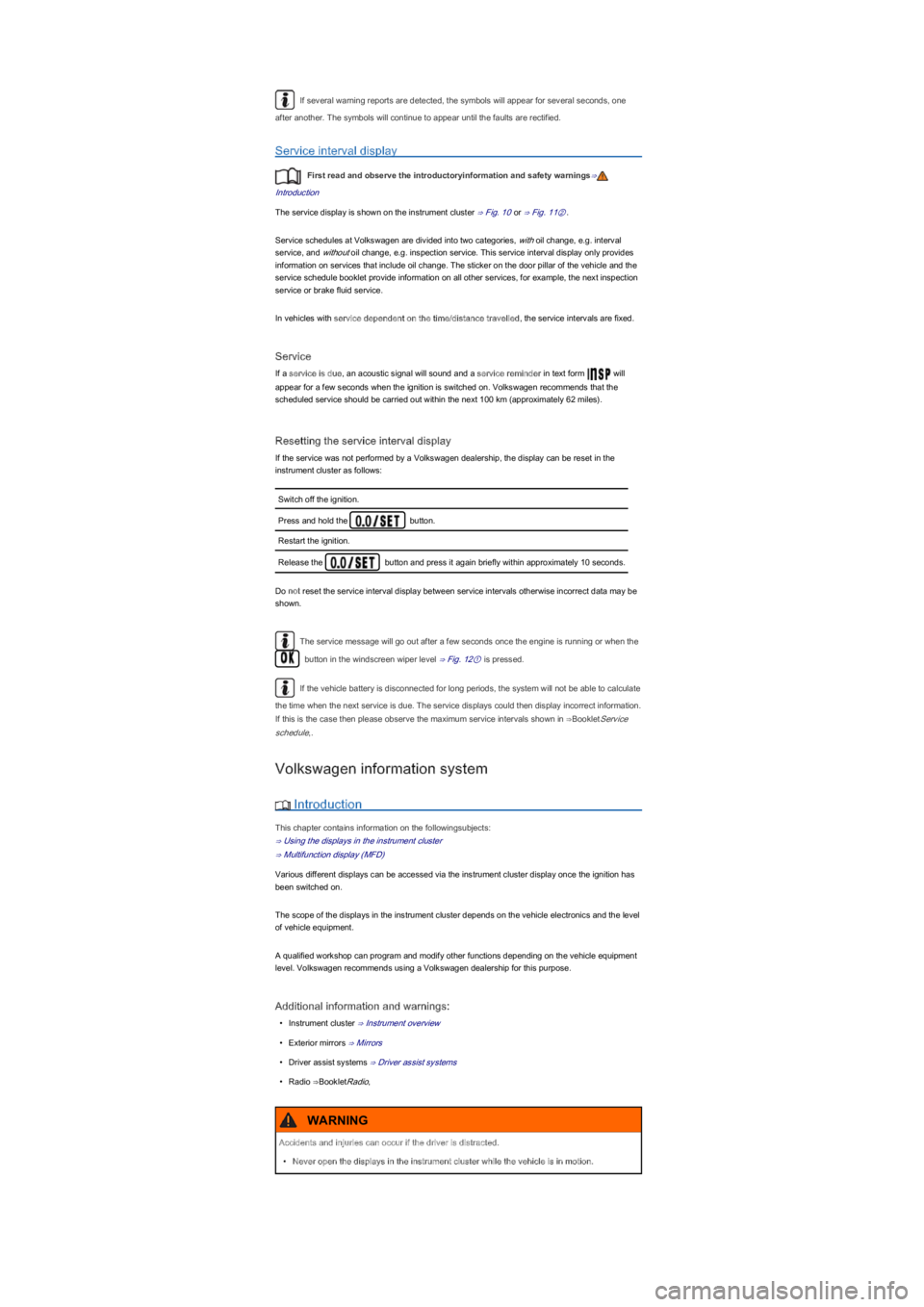
If several warning reports are detected, the symbols will appear for several seconds, one
after another. The symbols will continue to appear until the faults are rectified.
Service interval display
First read and observe the introductoryinformation and safety warnings⇒
Introduction
The service display is shown on the instrument cluster ⇒ Fig. 10 or ⇒ Fig. 11②.
Service schedules at Volkswagen are divided into two categories, with oil change, e.g. interval
service, and without oil change, e.g. inspection service. This service interval display only provides
information on services that include oil change. The sticker on the door pillar of the vehicle and the
service schedule booklet provide information on all other services, for example, the next inspection
service or brake fluid service.
In vehicles with service dependent on the time/distance travelled, the service intervals are fixed.
Service
If a service is due, an acoustic signal will sound and a service reminder in text form will
appear for a few seconds when the ignition is switched on. Volkswagen recommends that the
scheduled service should be carried out within the next 100 km (approximately 62 miles).
Resetting the service interval display
If the service was not performed by a Volkswagen dealership, the display can be reset in the
instrument cluster as follows:
Switch off the ignition.
Press and hold the button.
Restart the ignition.
Release the button and press it again briefly within approximately 10 seconds.
Do not reset the service interval display between service intervals otherwise incorrect data may be
shown.
The service message will go out after a few seconds once the engine is running or when the
button in the windscreen wiper level ⇒ Fig. 12① is pressed.
If the vehicle battery is disconnected for long periods, the system will not be able to calculate
the time when the next service is due. The service displays could then display incorrect information.
If this is the case then please observe the maximum service intervals shown in ⇒BookletService
schedule,.
Volkswagen information system
Introduction
This chapter contains information on the followingsubjects:
⇒ Using the displays in the instrument cluster
⇒ Multifunction display (MFD)
Various different displays can be accessed via the instrument cluster display once the ignition has
been switched on.
The scope of the displays in the instrument cluster depends on the vehicle electronics and the level
of vehicle equipment.
A qualified workshop can program and modify other functions depending on the vehicle equipment
level. Volkswagen recommends using a Volkswagen dealership for this purpose.
Additional information and warnings:
•Instrument cluster ⇒ Instrument overview
•Exterior mirrors ⇒ Mirrors
•Driver assist systems ⇒ Driver assist systems
•Radio ⇒BookletRadio,
Accidents and injuries can occur if the driver is distracted.
•Never open the displays in the instrument cluster while the vehicle is in motion.
WARNING
Page 115 of 211
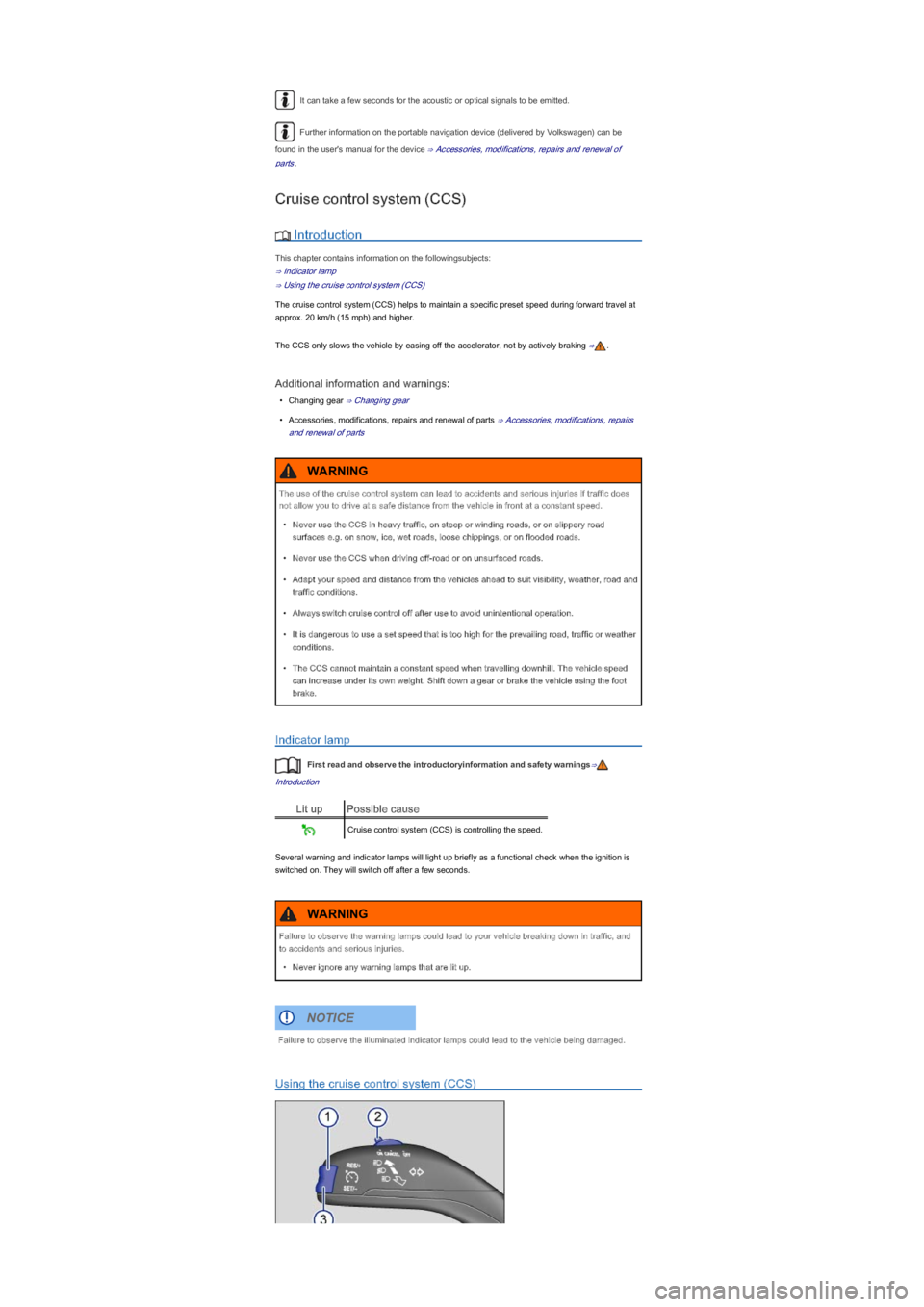
It can take a few seconds for the acoustic or optical signals to be emitted.
Further information on the portable navigation device (delivered by Volkswagen) can be
found in the user's manual for the device ⇒ Accessories, modifications, repairs and renewal of
parts.
Cruise control system (CCS)
Introduction
This chapter contains information on the followingsubjects:
⇒ Indicator lamp
⇒ Using the cruise control system (CCS)
The cruise control system (CCS) helps to maintain a specific preset speed during forward travel at
approx. 20 km/h (15 mph) and higher.
The CCS only slows the vehicle by easing off the accelerator, not by actively braking ⇒.
Additional information and warnings:
•Changing gear ⇒ Changing gear
•Accessories, modifications, repairs and renewal of parts ⇒ Accessories, modifications, repairs
and renewal of parts
Indicator lamp
First read and observe the introductoryinformation and safety warnings⇒
Introduction
Lit upPossible cause
Cruise control system (CCS) is controlling the speed.
Several warning and indicator lamps will light up briefly as a functional check when the ignition is
switched on. They will switch off after a few seconds.
Using the cruise control system (CCS)
The use of the cruise control system can lead to accidents and serious injuries if traffic does
not allow you to drive at a safe distance from the vehicle in front at a constant speed.
•Never use the CCS in heavy traffic, on steep or winding roads, or on slippery road
surfaces e.g. on snow, ice, wet roads, loose chippings, or on flooded roads.
•Never use the CCS when driving off-road or on unsurfaced roads.
•Adapt your speed and distance from the vehicles ahead to suit visibility, weather, road and
traffic conditions.
•Always switch cruise control off after use to avoid unintentional operation.
•It is dangerous to use a set speed that is too high for the prevailing road, traffic or weather
conditions.
•The CCS cannot maintain a constant speed when travelling downhill. The vehicle speed
can increase under its own weight. Shift down a gear or brake the vehicle using the foot
brake.
WARNING
Failure to observe the warning lamps could lead to your vehicle breaking down in traffic, and
to accidents and serious injuries.
•Never ignore any warning lamps that are lit up.
WARNING
Failure to observe the illuminated indicator lamps could lead to the vehicle being damaged.
NOTICE
Page 173 of 211
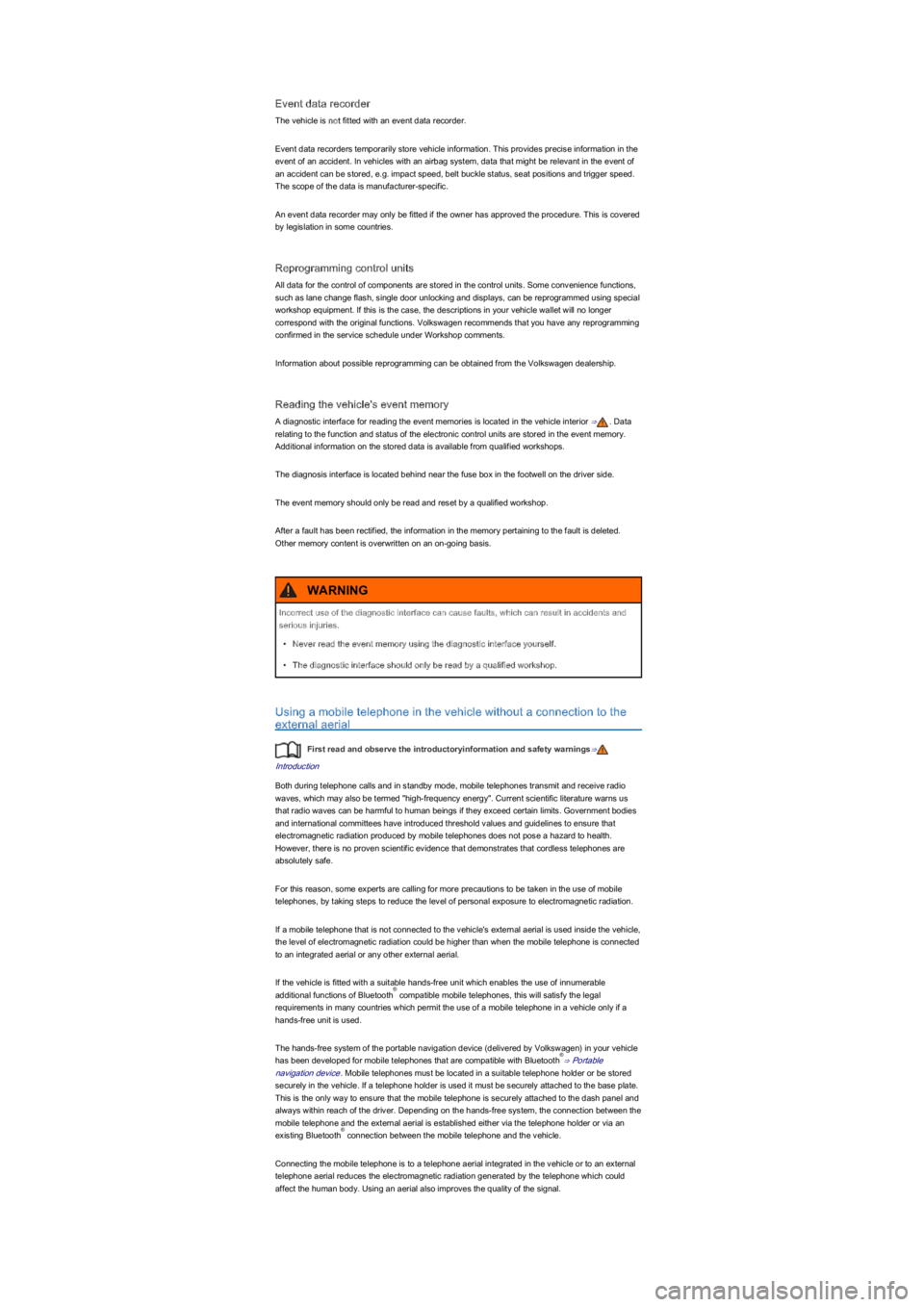
Event data recorder
The vehicle is not fitted with an event data recorder.
Event data recorders temporarily store vehicle information. This provides precise information in the
event of an accident. In vehicles with an airbag system, data that might be relevant in the event of
an accident can be stored, e.g. impact speed, belt buckle status, seat positions and trigger speed.
The scope of the data is manufacturer-specific.
An event data recorder may only be fitted if the owner has approved the procedure. This is covered
by legislation in some countries.
Reprogramming control units
All data for the control of components are stored in the control units. Some convenience functions,
such as lane change flash, single door unlocking and displays, can be reprogrammed using special
workshop equipment. If this is the case, the descriptions in your vehicle wallet will no longer
correspond with the original functions. Volkswagen recommends that you have any reprogramming
confirmed in the service schedule under Workshop comments.
Information about possible reprogramming can be obtained from the Volkswagen dealership.
Reading the vehicle's event memory
A diagnostic interface for reading the event memories is located in the vehicle interior ⇒. Data
relating to the function and status of the electronic control units are stored in the event memory.
Additional information on the stored data is available from qualified workshops.
The diagnosis interface is located behind near the fuse box in the footwell on the driver side.
The event memory should only be read and reset by a qualified workshop.
After a fault has been rectified, the information in the memory pertaining to the fault is deleted.
Other memory content is overwritten on an on-going basis.
Using a mobile telephone in the vehicle without a connection to the
external aerial
First read and observe the introductoryinformation and safety warnings⇒
Introduction
Both during telephone calls and in standby mode, mobile telephones transmit and receive radio
waves, which may also be termed "high-frequency energy". Current scientific literature warns us
that radio waves can be harmful to human beings if they exceed certain limits. Government bodies
and international committees have introduced threshold values and guidelines to ensure that
electromagnetic radiation produced by mobile telephones does not pose a hazard to health.
However, there is no proven scientific evidence that demonstrates that cordless telephones are
absolutely safe.
For this reason, some experts are calling for more precautions to be taken in the use of mobile
telephones, by taking steps to reduce the level of personal exposure to electromagnetic radiation.
If a mobile telephone that is not connected to the vehicle's external aerial is used inside the vehicle,
the level of electromagnetic radiation could be higher than when the mobile telephone is connected
to an integrated aerial or any other external aerial.
If the vehicle is fitted with a suitable hands-free unit which enables the use of innumerable
additional functions of Bluetooth compatible mobile telephones, this will satisfy the legal
requirements in many countries which permit the use of a mobile telephone in a vehicle only if a
hands-free unit is used.
The hands-free system of the portable navigation device (delivered by Volkswagen) in your vehicle
has been developed for mobile telephones that are compatible with Bluetooth⇒ Portable
navigation device. Mobile telephones must be located in a suitable telephone holder or be stored
securely in the vehicle. If a telephone holder is used it must be securely attached to the base plate.
This is the only way to ensure that the mobile telephone is securely attached to the dash panel and
always within reach of the driver. Depending on the hands-free system, the connection between the
mobile telephone and the external aerial is established either via the telephone holder or via an
existing Bluetooth connection between the mobile telephone and the vehicle.
Connecting the mobile telephone is to a telephone aerial integrated in the vehicle or to an external
telephone aerial reduces the electromagnetic radiation generated by the telephone which could
affect the human body. Using an aerial also improves the quality of the signal.
Incorrect use of the diagnostic interface can cause faults, which can result in accidents and
serious injuries.
•Never read the event memory using the diagnostic interface yourself.
•The diagnostic interface should only be read by a qualified workshop.
WARNING
®
®
®